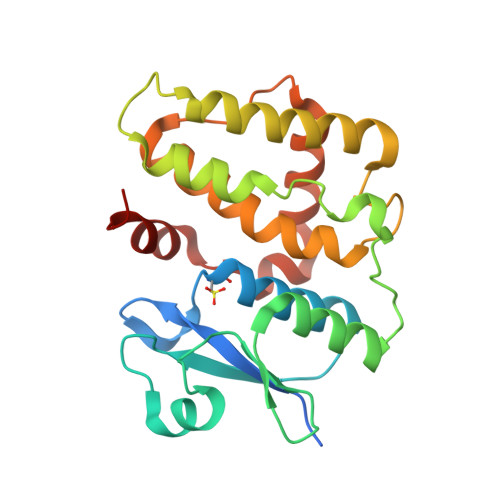Structural understanding of the recycling of oxidized ascorbate by dehydroascorbate reductase (OsDHAR) from Oryza sativa L. japonica
Do, H., Kim, I.S., Jeon, B.W., Lee, C.W., Park, A.K., Wi, A.R., Shin, S.C., Park, H., Kim, Y.S., Yoon, H.S., Kim, H.W., Lee, J.H.(2016) Sci Rep 6: 19498-19498
- PubMed: 26775680
- DOI: https://doi.org/10.1038/srep19498
- Primary Citation of Related Structures:
5D9T, 5D9V, 5D9W, 5D9X - PubMed Abstract:
Dehydroascorbate reductase (DHAR) is a key enzyme involved in the recycling of ascorbate, which catalyses the glutathione (GSH)-dependent reduction of oxidized ascorbate (dehydroascorbate, DHA). As a result, DHAR regenerates a pool of reduced ascorbate and detoxifies reactive oxygen species (ROS). In previous experiments involving transgenic rice, we observed that overexpression of DHAR enhanced grain yield and biomass. Since the structure of DHAR is not available, the enzymatic mechanism is not well-understood and remains poorly characterized. To elucidate the molecular basis of DHAR catalysis, we determined the crystal structures of DHAR from Oryza sativa L. japonica (OsDHAR) in the native, ascorbate-bound, and GSH-bound forms and refined their resolutions to 1.9, 1.7, and 1.7 Å, respectively. These complex structures provide the first information regarding the location of the ascorbate and GSH binding sites and their interacting residues. The location of the ascorbate-binding site overlaps with the GSH-binding site, suggesting a ping-pong kinetic mechanism for electron transfer at the common Cys20 active site. Our structural information and mutagenesis data provide useful insights into the reaction mechanism of OsDHAR against ROS-induced oxidative stress in rice.
Organizational Affiliation:
Division of Polar Life Sciences, Korea Polar Research Institute, Incheon 406-840, Republic of Korea.

















